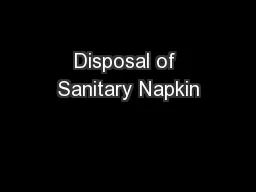

It happens to us 146617293 girls and women Why is a normal vital process of human existence Menstruation considered contaminated dirty amp impure Reproductive Right What Is MHM ID: 268681
Download Presentation The PPT/PDF document "Disposal of Sanitary Napkin" is the property of its rightful owner. Permission is granted to download and print the materials on this web site for personal, non-commercial use only, and to display it on your personal computer provided you do not modify the materials and that you retain all copyright notices contained in the materials. By downloading content from our website, you accept the terms of this agreement.
Slide1
Disposal of Sanitary NapkinSlide2
It happens to us
14,66,17,293
girls and women
Why is a normal vital process of human existence –Menstruation - considered contaminated, dirty & impure
Reproductive RightSlide3
What Is MHM
Women and adolescent girls using a clean menstrual management material o absorb or collect blood that can be changed in privacy as often as necessary for the duration of the menstruation period, using soap and water for washing the body as required, and having access to facilities to dispose of used menstrual management materials.
Source-UNICEF and WHO,
2014Slide4
100%
87%
70%
74%
Formative Research in U.P with menstruating adolescents – UNICEF,
2012
Had No dialogue on Menstruation
Old (unhygienic) cloth to manage
Rural India women still use
unsanitaized
cloth
Fathers were in favour of preparing girls for their first menstruation
64%
household do not have toilets in U.P Slide5
Do You Know...
“Average women will throw nearly
16,800
pads in her life cycle” “Nothing inherently wrong in reusing”Slide6
Disposable Sanitary Napkin
Top layer – is made of polypropylene-a plastic fleece
Padding- wood pulp mixed with SAP(plastic based gel)
Leak proof Contrary to popular belief, most disposal sanitary napkins are made almost entirely of plasticSlide7Slide8
Health & Environmental Effects
Most disposal pads end up as
unsegregated
household waste or are burned along with domestic waste-releasing toxins from the plastics.Source of the harmful chemicals that can be used in sanitary napkins - Use of chlorine bleach to whiten the product that bleaching process does not sterilise anything . It only ensure that the products are white. The process results in the production of dioxin-a type of “organochlorine” as it DDT, PCBs and Agent organs, that is linked to cancer, especially breast cancer, immune system suppression, endometriosis, pelvic inflammatory diseases, and sperm count - Artificial Fragrances – added to napkins can cause local allergies and skin reaction - Insecticides and herbicides – sprayed on cotton crop especially ‘Furan’ stay on cotton for long after it is harvested.Pad takes 500 years to degrade. Every year we add equivalent of 180 billion plastic bags to our waste by using plastic laden feminine hygiene products.Slide9
Local solutions in offer
Women practicing disposal of menstrual waste in their home
Identification mark on walls to search out families using home based mechanism (
Matka) for disposal of menstrual wasteSlide10
Local solutions in offer
Incinerator construction in Schools
Girls gaining hands-on knowledge on disposal of menstrual waste via incinerator
Slide11
Menstrual Hygiene Scheme
20 States
152 Districts
1.5 crore Adolescent Girls90 million pads per month
DISPOSAL is still a challenge ??Slide12
Thank You